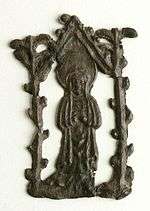Gerard Flaitel
Gerard Flaitel († c. 1047) was a Norman knight and a ' most powerful lord in Normandy at the time of the Richards' according to Orderic Vitalis.

Life
Gerard was a Norman baron with substantial estates in the Pays de Caux, the Hiemois, the Evrecin and Risle valley.[1] He was a vassal of William of Talou in Arques.[2]
In 1035, when Robert I, Duke of Normandy left on a pilgrimage to Jerusalem, Gerard Flaitel was one of his companions.[3] In the spring of 1035 the group left Normandy probably taking the favored route through the Danube river basin to Constantinople.[4] Duke Robert obtained permission for him and his retinue to continue on to Muslim-controlled Jerusalem.[4] In Turkey Robert paid the required mussella (pilgrim tax).[3] They arrived in time to spend Holy Week in Jerusalem.[3] On their return through Asia Minor, Duke Robert fell ill while they were in Nicaea, and died there about 2 July. As he lay dying Gerard was asked to take possession of a Holy relic Robert acquired in Jerusalem, reputedly a finger-bone of Saint Stephen, and to make a gift of it to the abbey or monastery of his choosing.[3] Gerard returned to Normandy and became a monk at the Abbey of St. Wandrille taking the relic with him.[3] He died after 1047.[5]
Family
While the name of his wife (or wives) is not known Gerard Flaitel had at least the following children:
- William Flaitel, Bishop of Évreux († 1066).[6]
- Ermengarde, wife of Walter Giffard, Lord of Longueville.[6]
- Basilla, wife of Ralph de Gacé, son of Robert, Archbishop of Rouen and secondly of Hugh de Gournay.[7]
- Anscherius[8]
References
- Véronique Gazeau, Normannia Monastica (xe–XIIe Siècle) (Caen : Publications du CRAHM, 2007), p. 492
- Ordericus Vitalis, The Ecclesiastical History of England and Normandy, Trans. Robert Forester, Vol. I (London: Henry G. Bohn, 1853), p. 400
- David Crouch, The Normans (London: Hambledon Continuum, 2007), p. 54
- David Crouch, The Normans (London: Hambledon Continuum, 2007), p. 53
- David Douglas, 'The Norman Episcopate before the Norman Conquest', Cambridge Historical Journal, Vol. 13, No. 2 (1957), p. 102 n. 15
- Detlev Schwennicke, Europäische Stammtafeln: Stammtafeln zur Geschichte der Europäischen Staaten, Neue Folge, Band III, Tielband 4 (Marburg, Germany: J. A. Stargardt, 1989), Tafel 695
- K.S.B. Keats-Rohan, Domesday People, A Prosopography of Persons Occurring in English Documents 1066-1166, Volume I, Domesday Book (Woodbridge: The Boydell Press, 1999), p. 263
- T.J. Pettigrew, 'On the House of Gournay', Collectanea Archæologica: Communications made to the British Archaeological Association, Vol. II (1871). p. 184